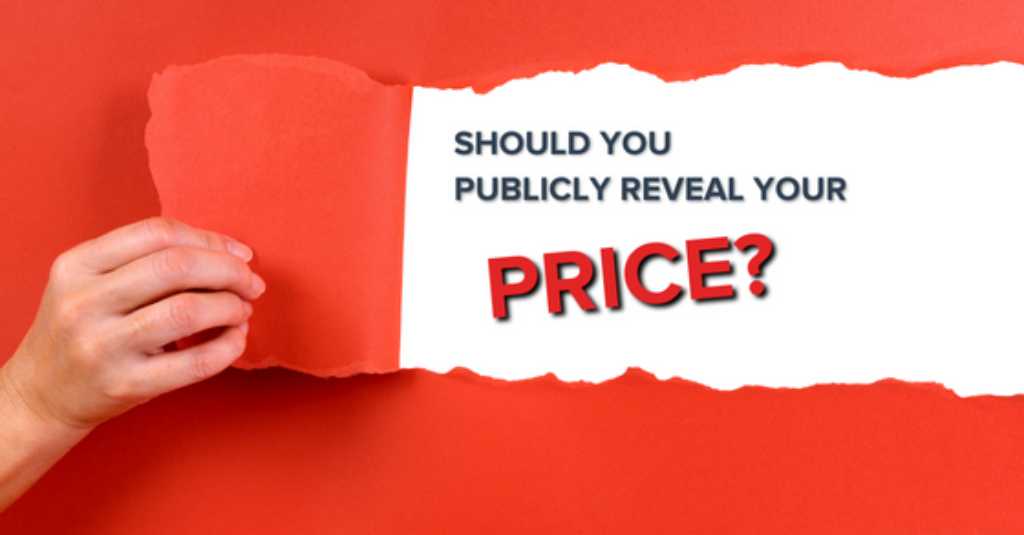Most buyers want to know the price of a product or service before they make a purchase. By being transparent with your prices on your website, you can build trust with potential customers and stand apart from the pack. Despite this, some argue that sharing price on your website can do more harm than good. So, what should you do?
Do you believe you need to share the price of your services and products on your website? Chances are if you’re reading this you’re somewhere on the spectrum of cynical and 100% bought in. If you’re unsure about sharing your prices online, we’re going to cover the arguments on why doing so is an absolute necessity.
In particular, we’re going to cover:
Why You Should Share Price on Your Website
There are a few reasons why you should prices on your website. These include:
- Building trust and transparency
- Helps you price your services higher
- If you don’t address cost, someone else will, and you will lose trust
- Cost articles can be used to close more deals
Let’s delve into each of these.
Building Trust and Transparency
Think back to a scenario when you last researched something online, anything from a domestic mould removal service to a fancy restaurant – and you didn’t find the price. What’s the emotion you felt? I’m guessing frustrated or what we like to call the F word of the internet.
So you don’t find the pricing online and you feel frustrated. But why? What gives you the right to be frustrated? The answer is you are the customer. You have the right to know, you know they know and you are trying to give them your money.
Guess how long it takes for you to leave a website if they don’t have the price and go to a competitor? The research says 10s or less. So why do we treat our own customers this way and expect them to act differently?
If you’re selling products or services online, sharing price information on your website is essential. Not only does it let potential customers know what you’re offering, but it also helps to build trust and transparency. After all, if you’re upfront about pricing, it shows that you’re confident in your product or service and that you’re not trying to hide anything.
When people are in the buying process and they search online for answers to their questions, at some point, they’re going to search for price. When they can’t find price on your website, they’re going to assume you’re trying to hide something, and they’ll become what? You guessed it, the F word of the internet: frustrated. This frustration translates to a loss of trust, and a lower chance for them to buy with your company.
On the other hand, if your prices are clearly listed, it shows that you’re transparent and have nothing to hide. More importantly, it helps you stand apart from the pack and be seen as the most trusted player in your space.
Helps you price your services higher
When you share your price on your website, what you’re actually doing is explaining all of the factors that influence your price. This has an interesting effect – by showing potential buyers why your price is a certain amount, you have the opportunity to explain the value that your company provides customers.
It’s a known fact that in the absence of value people will compare you on price. So, we’re not suggesting throwing up your price list willy nilly, explain those factors and the value to showcase your complete value offering.
On top of this, in some cases, people may not be aware of all the factors that go into your pricing. By sharing this information on your website, you can help educate them and show them why your rates are fair and reasonable. This can go a long way in winning their business.
When you share your price on the website, the customer learns not only of your price, but also:
- Of your company’s services and products
- Of how your company’s services and products can add value to them
- The reasons behind your price, and justification for why your company might be more expensive (and therefore more desirable) than competitors
This gives you the opportunity to price your services higher and ultimately differentiate yourself from the competition.
If you don’t address cost, someone else will
Let’s face it—if someone is interested in your product or service, they’re going to do their research before making a purchase. If they can’t find pricing information on your site, they’ll likely go to one of your competitors who does share this information. You don’t want to lose out on business because you were too afraid to address cost head-on.
‘What about if no one shares their pricing online in our industry. It’s not done!’’ someone might say. Well, isn’t that more of a reason to stand-out from the pack? In fact, if no one is sharing pricing online in your space it is an even BIGGER opportunity to establish yourself as the most trusted player in your industry.

Cost articles can be used to close more deals
Cost articles can be used in the sales process as pieces of assignment selling. Assignment selling is where you assign “homework” to your prospect in the form of educational blog articles or videos anytime during the sales cycle. This has the effect of increasing close rates from 15-20% up to 80% and decreasing the lifetime of the sales lifecycle, ultimately helping you close more deals in less time.
Cost articles are one of the 5 topics that most prospects have questions on, and as such these can be used in the sales process to answer buyer questions, win trust, and ultimately win more business.
3 common arguments for sharing price on your website and why they’re weak
Generally speaking, businesses who refuse to share this information say one of three things:
- Our products and services are custom-designed for individual situations
- Our competitors would know what we’re charging
- We might scare prospects away before we can explain the costs to them
Let’s take a look at each of these.
Our products and services are custom-designed for individual situations…
While every project you do may be different, and many factors might influence the final cost resulting in varying prices, you STILL need to explain this to your potential buyer to build trust.
See the thing is Google (to rank) and buyers (to purchase) don’t necessarily need a price list, all they want is a discussion of the factors that impact price. If the answer to what is your price is ‘it depends’, go into detail what that means.
Moby Siddique, CEO @RedPandas
Explain the factors that influence price, and at the very least, give them a price range or a “our prices start from” statement.
Our competitors would know what we’re charging…
Let me ask you a question: do you know what your competitors are charging? You probably just said something along the lines of ‘I have an idea of what my competitors charge, sure.
If you’ve been around then with very little research you should have an idea of what your competitors are charging.
My point is that if you know what your competitors are charging already, doesn’t it make sense that they probably know what you’re charging? And if they already know what you’re charging, does it really make a difference whether or not you put your prices on the website?
Why would you let your competitors get in the way of you being the most trusted and transparent voice in your industry?
It might scare away prospects…
If you are open about your pricing and someone walks away because they can’t afford you, then all you’ve lost is a lead that you were going to waste time on trying to close but who was going to walk anyway.
In other words, if you put pricing on your website, you actually attract the right customers and drive away those that aren’t best suited to working with you. This saves you time by helping you qualify or disqualify potential buyers early on.
On top of this, even if they can’t afford you, this honesty builds trust, which leaves positive sentiment for your brand in their mind and helps you get more sales in the long run, because people want to do business with businesses that they can trust.
Remember, in the absence of value people will compare you on price. So, your job isn’t just to transparently share your price (or pricing range) but also do so with demonstrated value. Here’s an example of how we do this.
Examples of Cost Articles
- RedPandas Pricing Page
- The Cost of a They Ask, You Answer Coaching Program
- HubSpot Pricing 2022 Package Comparison
So, what should you do next?
The first thing to do is to get started on writing a blog article on your website that addresses the pricing of your services and the factors that influence your pricing.
Not sure how to write your article? You might be interested in reading our guide on writing blog articles that rank and generate sales.
Once you’ve done this, there’s a few other things that you should be addressing on your website if you want to start generating more leads and sales. You can learn about the 5 topics that are essential to include on your website here.













